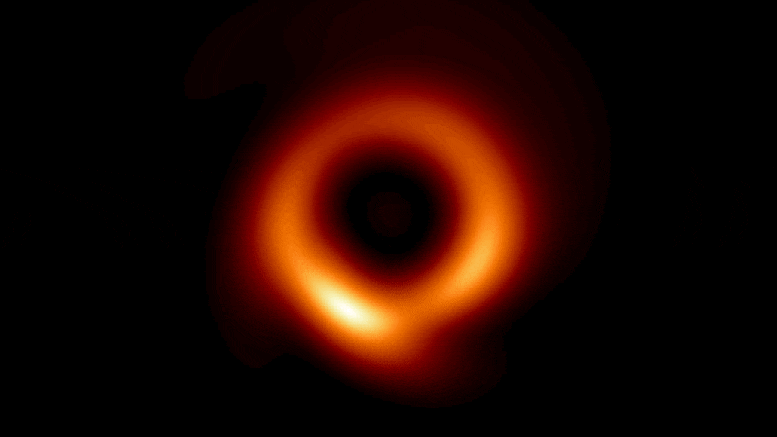صورة جديدة لثقب أسود فائق الكتلة M87 تم إنشاؤها بواسطة خوارزمية PRIMO باستخدام بيانات 2017 EHT. الائتمان: Medeiros et al. 2023
يعيد التعلم الآلي بناء صورة جديدة من بيانات EHT.
صورة M87[{” attribute=””>black hole has been enhanced using a machine learning technique called PRIMO, providing a more accurate representation and allowing for improved determinations of its mass and physical parameters.
The iconic image of the supermassive black hole at the center of M87—sometimes referred to as the “fuzzy, orange donut”—has gotten its first official makeover with the help of machine learning. The new image further exposes a central region that is larger and darker, surrounded by the bright accreting gas shaped like a “skinny donut.” The team used the data obtained by the Event Horizon Telescope (EHT) collaboration in 2017 and achieved, for the first time, the full resolution of the array.
In 2017, the EHT collaboration used a network of seven pre-existing telescopes around the world to gather data on M87, creating an “Earth-sized telescope.” However, since it is infeasible to cover the Earth’s entire surface with telescopes, gaps arise in the data—like missing pieces in a jigsaw puzzle.

M87 supermassive black hole originally imaged by the EHT collaboration in 2019 (left); and new image generated by the PRIMO algorithm using the same data set (right). Credit: Medeiros et al. 2023
“With our new machine learning technique, PRIMO, we were able to achieve the maximum resolution of the current array,” says lead author Lia Medeiros of the Institute for Advanced Study. “Since we cannot study black holes up close, the detail of an image plays a critical role in our ability to understand its behavior. The width of the ring in the image is now smaller by about a factor of two, which will be a powerful constraint for our theoretical models and tests of gravity.”
PRIMO, which stands for principal-component interferometric modeling, was developed by EHT members Lia Medeiros (Institute for Advanced Study), Dimitrios Psaltis (Georgia Tech), Tod Lauer (NOIRLab), and Feryal Özel (Georgia Tech). Their publication, “The Image of the M87 Black Hole Reconstructed with PRIMO,” was published today (April 13) in The Astrophysical Journal Letters.
“PRIMO is a new approach to the difficult task of constructing images from EHT observations,” said Lauer. “It provides a way to compensate for the missing information about the object being observed, which is required to generate the image that would have been seen using a single gigantic radio telescope the size of the Earth.”

Animation fades from M87 black hole image, first produced by the EHT collaboration in 2019, to the new image generated by the PRIMO algorithm using the same data set. Credit: Medeiros et al. 2023
PRIMO relies on dictionary learning, a branch of machine learning which enables computers to generate rules based on large sets of training material. For example, if a computer is fed a series of different banana images—with sufficient training—it may be able to determine if an unknown image is or is not a banana. Beyond this simple case, the versatility of machine learning has been demonstrated in numerous ways: from creating Renaissance-style works of art to completing the unfinished work of Beethoven. So how might machines help scientists to render a black hole image? The research team has answered this very question.
With PRIMO, computers analyzed over 30,000 high-fidelity simulated images of black holes accreting gas. The ensemble of simulations covered a wide range of models for how the black hole accretes matter, looking for common patterns in the structure of the images. The various patterns of structure were sorted by how commonly they occurred in the simulations, and were then blended to provide a highly accurate representation of the EHT observations, simultaneously providing a high fidelity estimate of the missing structure of the images. A paper pertaining to the algorithm itself was published in The Astrophysical Journal on February 3, 2023.
“We are using physics to fill in regions of missing data in a way that has never been done before by using machine learning,” added Medeiros. “This could have important implications for interferometry, which plays a role in fields from exo-planets to medicine.”
https://www.youtube.com/watch؟v=d_KyEay2hi8
نظرة عامة على عمليات المحاكاة التي تم إنشاؤها لمجموعة التدريب على خوارزمية PRIMO. الائتمان: Medeiros et al. 2023
أكد الفريق أن الصورة المقدمة حديثًا تتوافق مع بيانات EHT ومع التوقعات النظرية ، بما في ذلك الحلقة الساطعة للانبعاثات المتوقع أن تنتج عن سقوط الغاز الساخن في الثقب الأسود. يتطلب إنشاء صورة افتراض الشكل المناسب للمعلومات المفقودة ، وقد فعل PRIMO ذلك من خلال البناء على اكتشاف 2019 أن الثقب الأسود M87 بتفاصيل واسعة بدا كما كان متوقعًا.
صرح Psaltis: “بعد أربع سنوات تقريبًا من الكشف عن أول صورة بمقياس أفقي لثقب أسود بواسطة EHT في عام 2019 ، قمنا بوضع علامة بارزة أخرى ، حيث أنتجنا صورة تستخدم الدقة الكاملة للمصفوفة لأول مرة”. “توفر تقنيات التعلم الآلي الجديدة التي طورناها فرصة ذهبية لعملنا الجماعي لفهم فيزياء الثقوب السوداء.”
يجب أن تؤدي الصورة الجديدة إلى تحديدات أكثر دقة لكتلة الثقب الأسود M87 والمعلمات الفيزيائية التي تحدد مظهره الحالي. توفر البيانات أيضًا فرصة للباحثين لوضع قيود أكبر على بدائل أفق الحدث (بناءً على انخفاض السطوع المركزي الداكن) وإجراء اختبارات أكثر قوة للجاذبية (بناءً على حجم الحلقة الأضيق). يمكن أيضًا تطبيق PRIMO على ملاحظات EHT الإضافية ، بما في ذلك ملاحظات Sgr A * ، الثقب الأسود المركزي في منطقتنا[{” attribute=””>Milky Way galaxy.
M87 is a massive, relatively nearby, galaxy in the Virgo cluster of galaxies. Over a century ago, a mysterious jet of hot plasma was observed to emanate from its center. Beginning in the 1950s, the then new technique of radio astronomy showed the galaxy to have a compact bright radio source at its center. During the 1960s, M87 had been suspected to have a massive black hole at its center powering this activity. Measurements made from ground-based telescopes starting in the 1970s, and later the Hubble Space Telescope starting in the 1990s, provided strong support that M87 indeed harbored a black hole weighing several billion times the mass of the Sun based on observations of the high velocities of stars and gas orbiting its center. The 2017 EHT observations of M87 were obtained over several days from several different radio telescopes linked together at the same time to obtain the highest possible resolution. The now iconic “orange donut” picture of the M87 black hole, released in 2019, reflected the first attempt to produce an image from these observations.
“The 2019 image was just the beginning,” stated Medeiros. “If a picture is worth a thousand words, the data underlying that image have many more stories to tell. PRIMO will continue to be a critical tool in extracting such insights.”
Reference: “The Image of the M87 Black Hole Reconstructed with PRIMO” by Lia Medeiros, Dimitrios Psaltis, Tod R. Lauer and Feryal Özel3, 13 April 2023, The Astrophysical Journal Letters.
DOI: 10.3847/2041-8213/acc32d
Development of the PRIMO algorithm was enabled through the support of the National Science Foundation Astronomy and Astrophysics Postdoctoral Fellowship.

. “محلل حائز على جوائز. محب للموسيقى. منشئ. هواة Twitter. مستكشف ودود. محب للتواصل ودود.”
